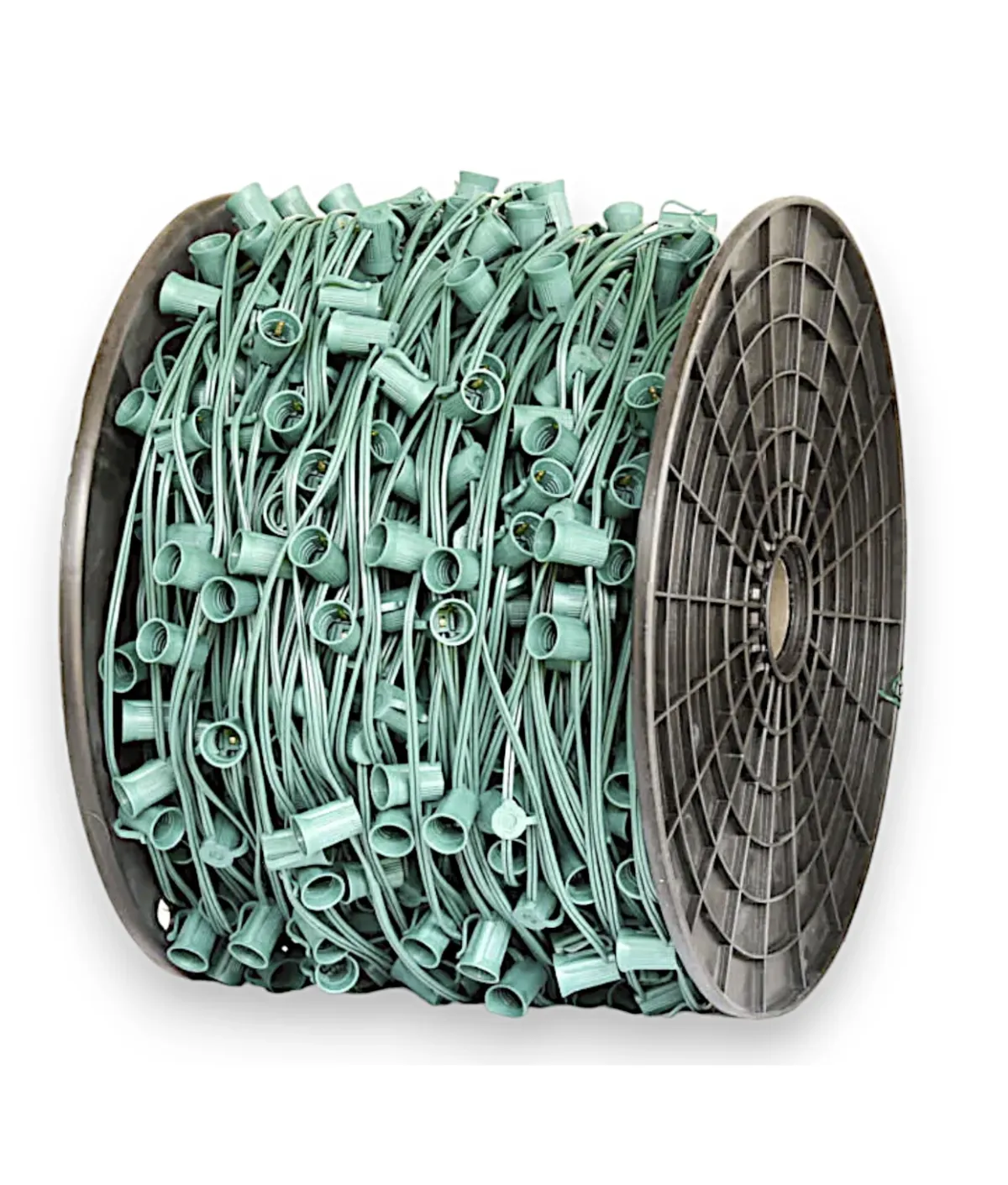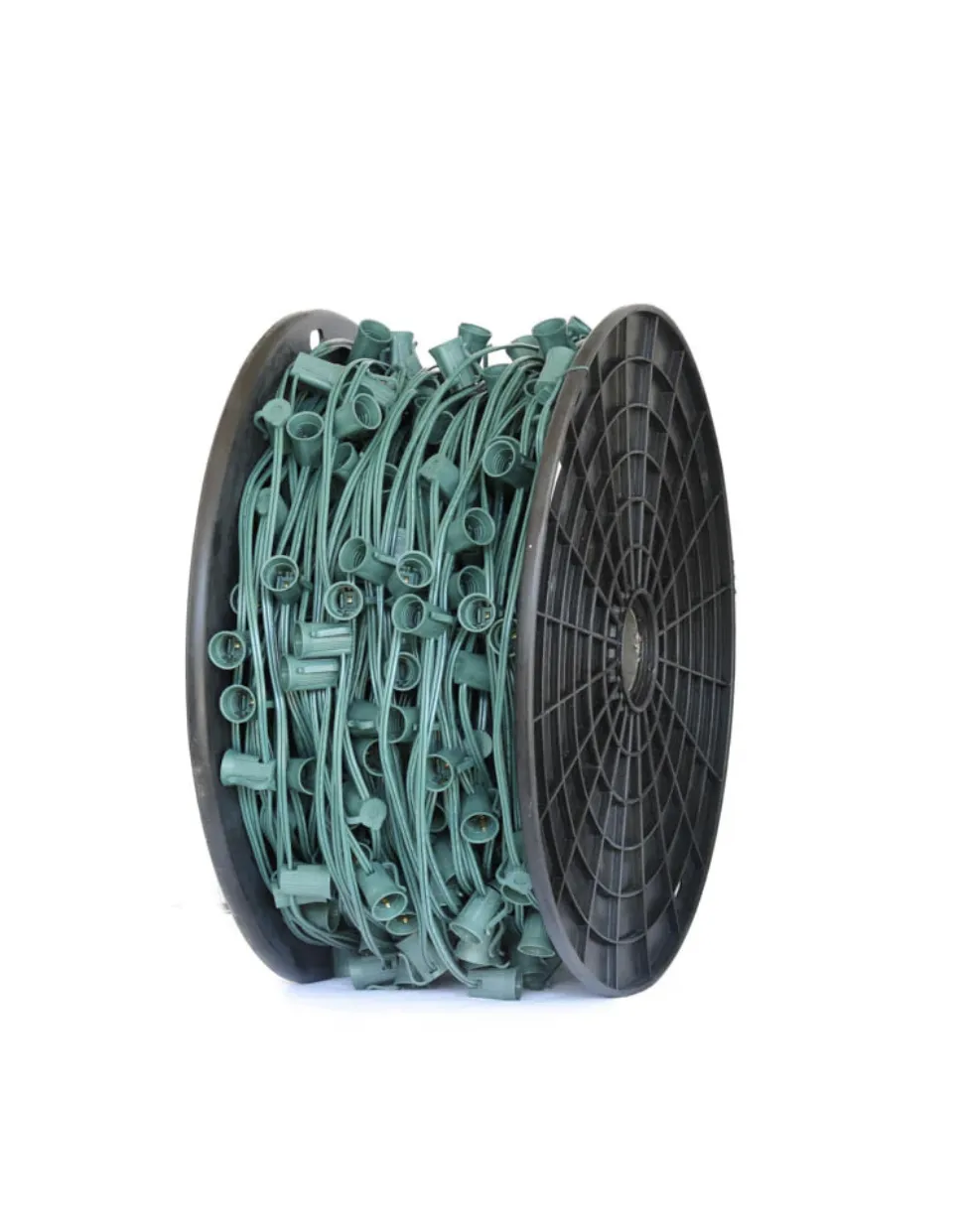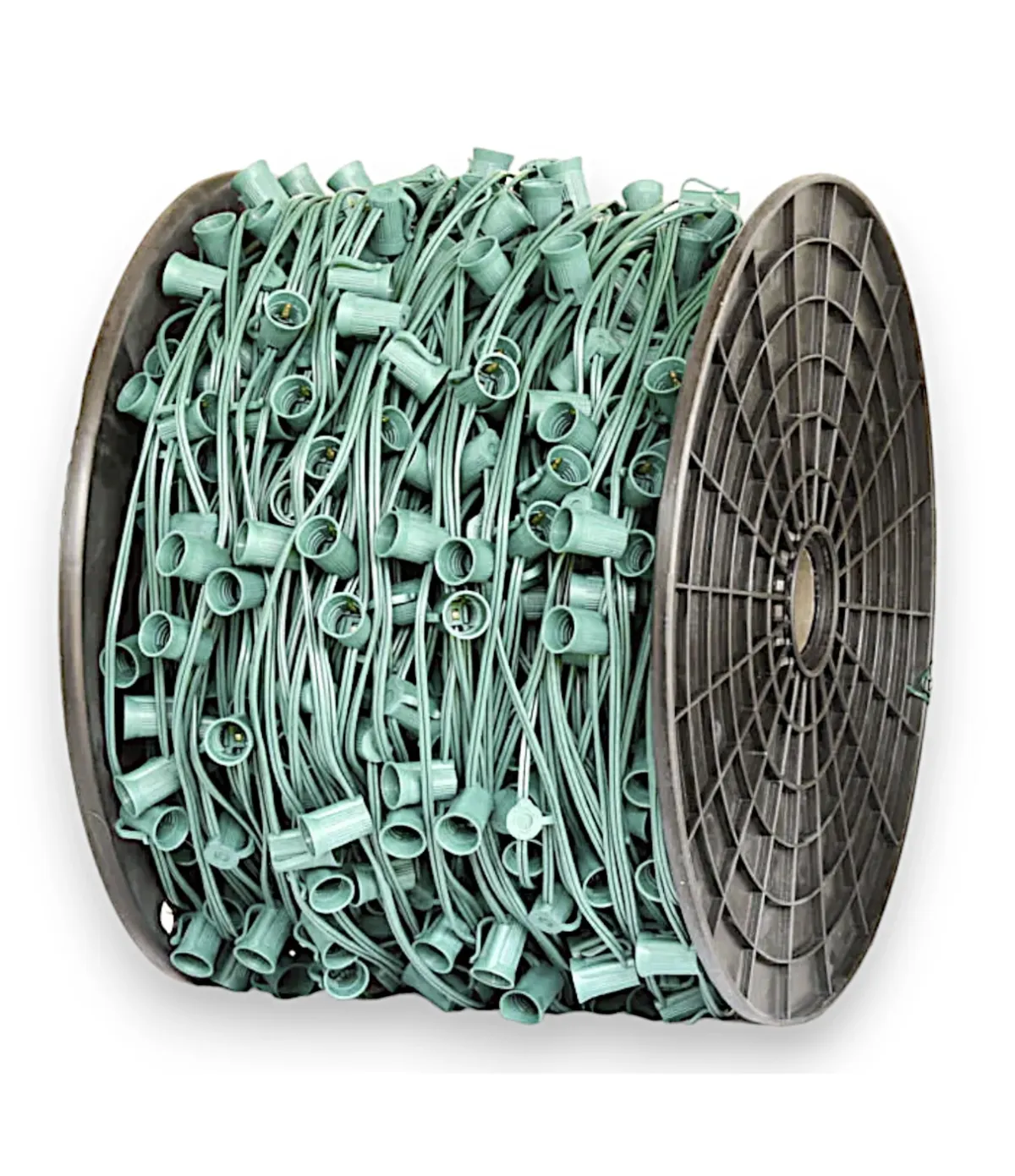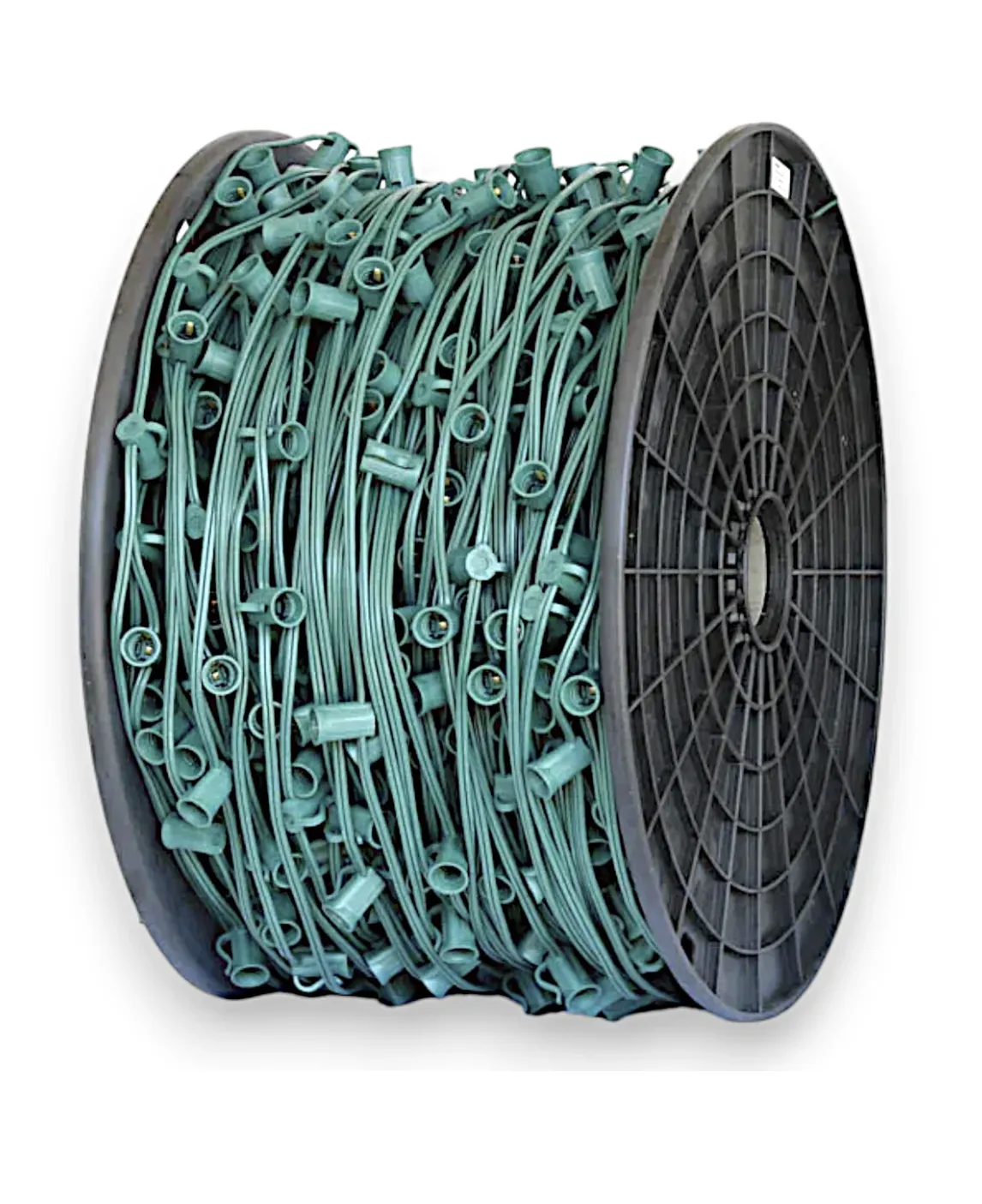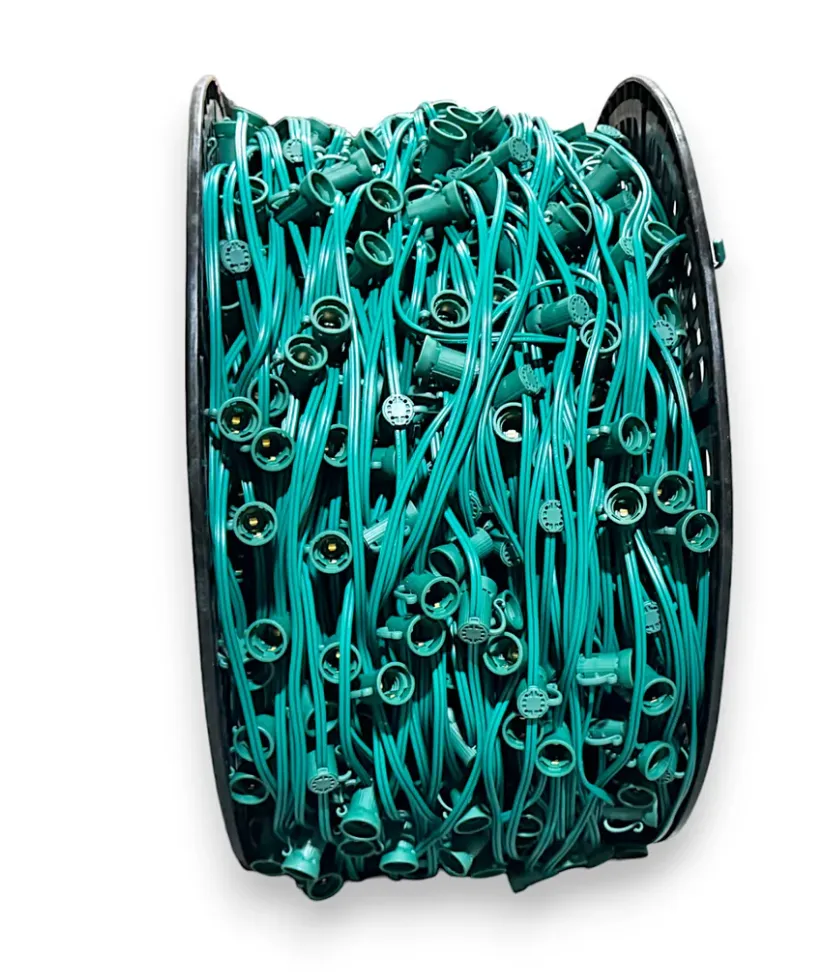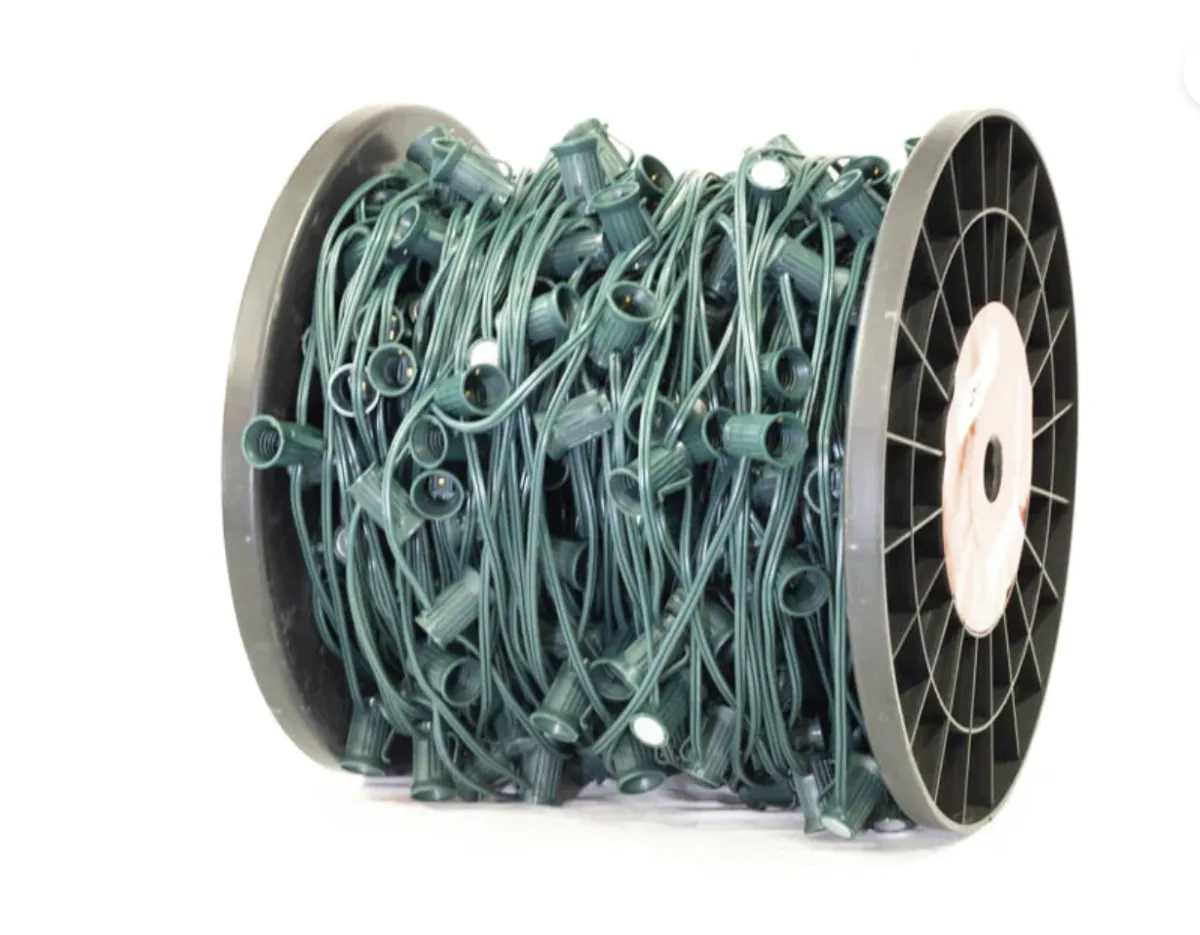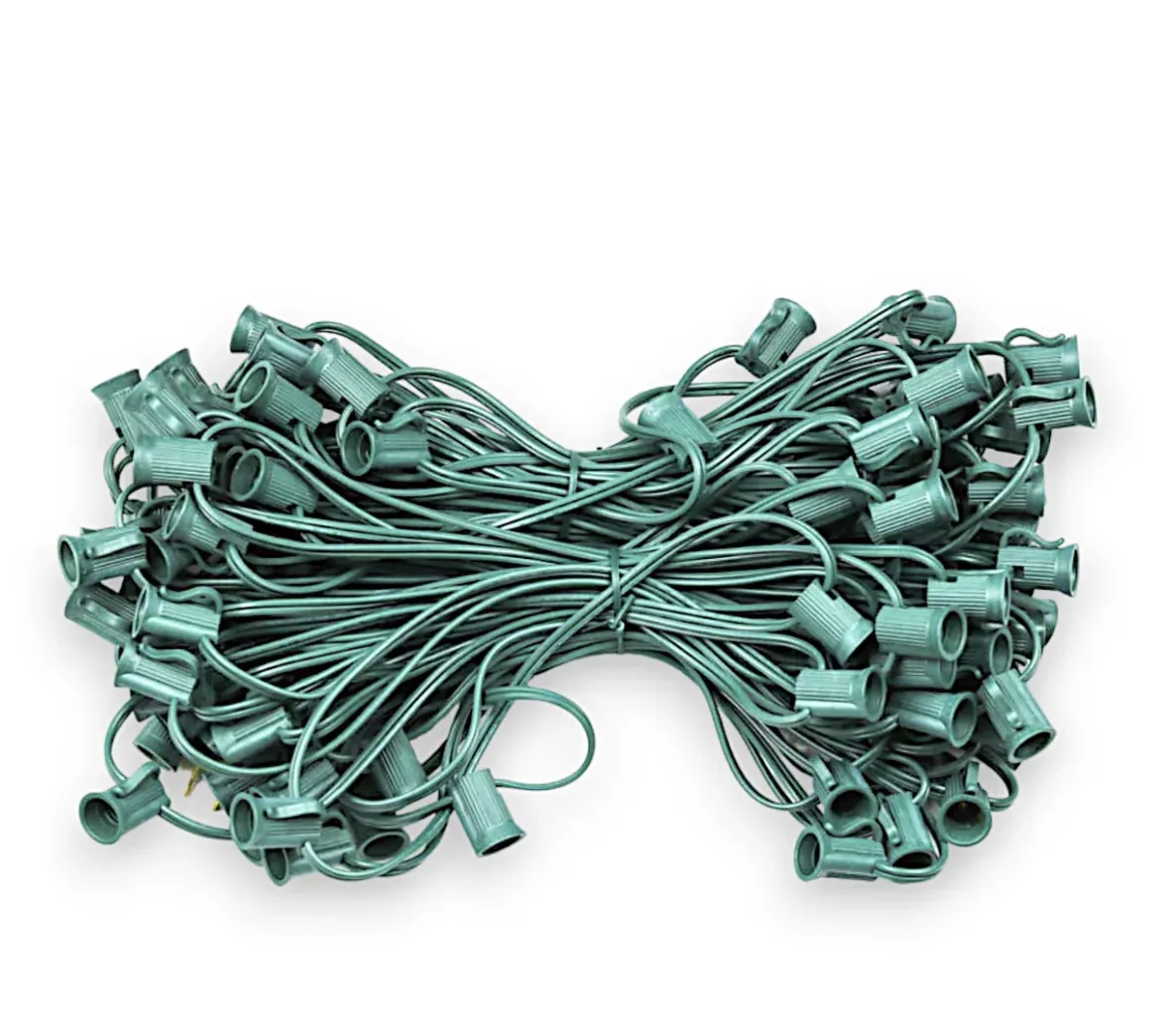C9 & C7 Socket Spools & Stringers
Discover our premium collection of socket wire spools and stringers, the essential foundation for creating stunning light displays. Designed for both professional installers and ambitious homeowners, our range includes bulk C7 and C9 socket wire spools with flexible spacing options, pre-made light stringers for quick setups, and convenient accessories like spool holders. These versatile, durable components are perfect for residential rooflines, enchanting tree displays, and large-scale commercial projects. Suitable for indoor and outdoor use, and compatible with both incandescent and LED bulbs, our professional-grade products offer the quality and flexibility needed to bring your creative lighting visions to life. Explore our selection and elevate your illumination projects with unmatched versatility and reliability.
Socket Spools
C9 1000' Socket Spool
Our C9 1000' Bulk Spool of Socket Wire, available in green or white, offers professional-grade flexibility for custom lighting projects. With spacing options from 6" to 48", it's ideal for both residential rooflines (12-15" spacing) and tree installations (24-48" spacing). The durable SPT-1 wire withstands outdoor conditions and is compatible with both incandescent and LED C9 bulbs. This customizable spool allows for precise length cutting, minimizing waste and maximizing efficiency for high-quality, adaptable lighting displays.
C9 500' Socket Spool
Our C9 500' Bulk Spool of Green Wire, available with 12" (500 sockets) or 15" (400 sockets) spacing, is perfect for professional-grade Christmas lighting installations. Featuring commercial-quality SPT-1, 8-amp wire and durable E17 sockets, this customizable spool is ideal for large-scale outdoor projects. Easily cut to desired lengths and pair with snap-on plugs (sold separately) for tailored lighting solutions in both residential and commercial settings. The 12" spacing offers vibrant, balanced lighting, while the 15" option provides a classic look with fewer bulbs per run.
C9 1000' 12"&15" Socket Wire Spool (SPT-2)
Our C9 1000' Socket Wire Spool (SPT-2) offers professional-grade flexibility with dual 12" and 15" spacing options. This customizable spool features heavy-duty SPT-2 wire for enhanced durability in all weather conditions. The 12" spacing is perfect for dense, vibrant displays on rooflines and pathways, while the 15" option provides a classic look with fewer bulbs per run. Compatible with both incandescent and LED C9 bulbs, this 1000' spool allows for precise cutting to fit any residential or commercial lighting project, ensuring efficient and long-lasting installations.
C7 1000' Green Wire Socket Spool (SPT-2)
Our 1000' bulk spool of green SPT-2 wire features 15" spacing with 1000 C7 sockets, ideal for commercial and residential outdoor displays. This 8-amp (960-watt) commercial-grade wire with Admiral Brand sockets allows for custom-length installations using snap-on plugs (sold separately). Suitable for indoor/outdoor use, it accommodates up to 160 sockets with 5-watt incandescent bulbs or 384 sockets with 1-watt LED bulbs per run. This versatile, durable C7 light line is perfect for creating professional-quality lighting displays in various settings.
C7 1000' Socket Spool
Our C7 1000' Bulk Spool of Socket Wire offers professional-grade flexibility for custom lighting projects. Available in green or white, with spacing options from 12" to 36", it's ideal for both residential rooflines (12-15" spacing) and tree installations (24-36" spacing). The durable SPT-1 wire withstands outdoor conditions and is compatible with both incandescent and LED C7 bulbs. This customizable spool allows for precise length cutting, minimizing waste and maximizing efficiency for high-quality, adaptable lighting displays in various settings.
C9/C7 500' Magnetic Spool
The Fastest Way to Install Holiday Lights on Metal Surfaces. Save time and effort this holiday season with Magnetic Spools. Designed for quick and easy installation, these magnetic spools are perfect for decorating your home or office building. The magnetic sockets eliminate the need for traditional mounting clips, making your installations faster and more efficient. Whether you’re lining rooflines, gutters, or fences, these spools are ideal for any surface where ferrous metal is present.
Available in 500' & 250', 12" or 15" Spacing.
Socket Wire Stringers
C9 12" Spacing Socket Wire Stringers
Our 25', 50' or 100' Holiday Light String features professional-grade, UV-protected 18-gauge wire with sockets spaced 12" apart. Designed for both indoor and outdoor use, these UL-recognized strings offer 5 Amp capacity SPT-1 insulation and durable sockets with weep holes for all-weather performance. Compatible with E12 Candelabra base bulbs (C7, C9, G30; sold separately), these versatile strings allow end-to-end connectivity for extended displays. Perfect for holiday decorations, event lighting, and year-round use in residential and commercial settings. Available in Green, White, Brown and Black.
C7 12" Spacing Socket Wire Stringers
Our professional-grade 25', 50' or 100' light string features sockets spaced 12" apart, perfect for commercial and residential decorators. Designed for both indoor and outdoor use, it's compatible with incandescent or LED C7, G30, and G40 bulbs (sold separately). The SPT-1 insulated wire offers 5 Amp capacity and includes weep-hole sockets for all-weather performance. With male and female plugs for end-to-end connections, these UL-recognized strings can handle up to 480 watts per run. Ideal for holiday displays, patio lighting, and year-round events, these durable strings ensure long-lasting, brilliant illumination for any occasion. Available in Green, White, Brown and Black.
Frequently Asked Questions
What's the difference between socket wire spools and stringers?
cket wire spools are bulk reels of wire with sockets at regular intervals, allowing for custom-length cuts. Stringers are pre-cut lengths of socket wire, typically with plugs attached, ready for immediate use.
Can I use the same socket wire for both C7 and C9 bulbs?
No, C7 and C9 bulbs require different socket sizes. Always check the product specifications to ensure you're using the correct socket wire for your chosen bulb type.
How do I determine the right spacing for my project?
Common spacings are 12", 15", and 24". Use closer spacing (12"-15") for dense, vibrant displays on rooflines or fences. Wider spacing (24" or more) works well for tree wrapping or creating a more subtle effect.
Are these socket wires suitable for outdoor use?
Most of our socket wires are rated for both indoor and outdoor use. Look for products labeled as "weatherproof" or "outdoor-rated" for the best durability in external conditions.
How many bulbs can I safely connect on a single run?
This depends on the wire's amperage rating and the wattage of your bulbs. For example, on an 8-amp wire, you can typically run up to 160 sockets with 5-watt incandescent bulbs or 384 sockets with 1-watt LED bulbs. Always check the product specifications and local electrical codes for safe operation.
Discover Expert Tips on Our Blog
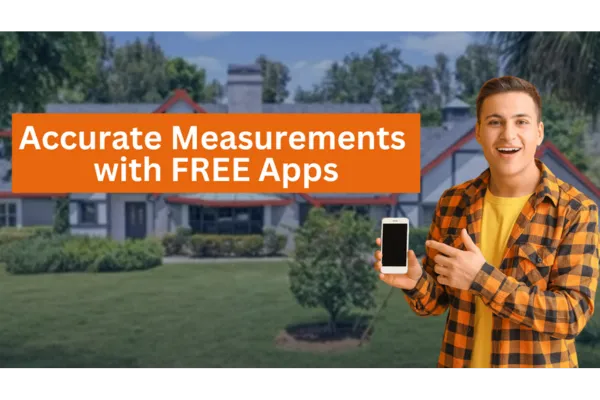
House Measurement Techniques for Accurate Bidding
When it comes to construction, renovation, or holiday decoration projects, accurate measurements are crucial. One wrong calculation can significantly impact your budget and timeline. Today, we'll explore three powerful free tools that help you measure buildings accurately from photos, ensuring your estimates are spot-on every time.
Why Accurate Measurements Matter
Consider this scenario: if you estimate a project at 140 feet when it's actually 200 feet, your cost calculations could be dramatically off. What started as $4 per foot might suddenly become $1 per foot, severely impacting your profit margins or project budget. This is why having reliable measuring techniques is essential for any contractor or DIY enthusiast.
Tool #1: ELEIF - The Professional's Choice
Measure in photo online ‐ eleif.net
ELEIF is a time-tested online measurement tool that offers precise calculations from photographs. Here's how to use it:
1. Upload your photo by dragging it into the interface
2. Set your reference measurement (typically a door width of 3 feet)
3. Use the measurement tool to mark key points along your structure
4. Record and add up all measurements
5. Add a 10% buffer for accuracy
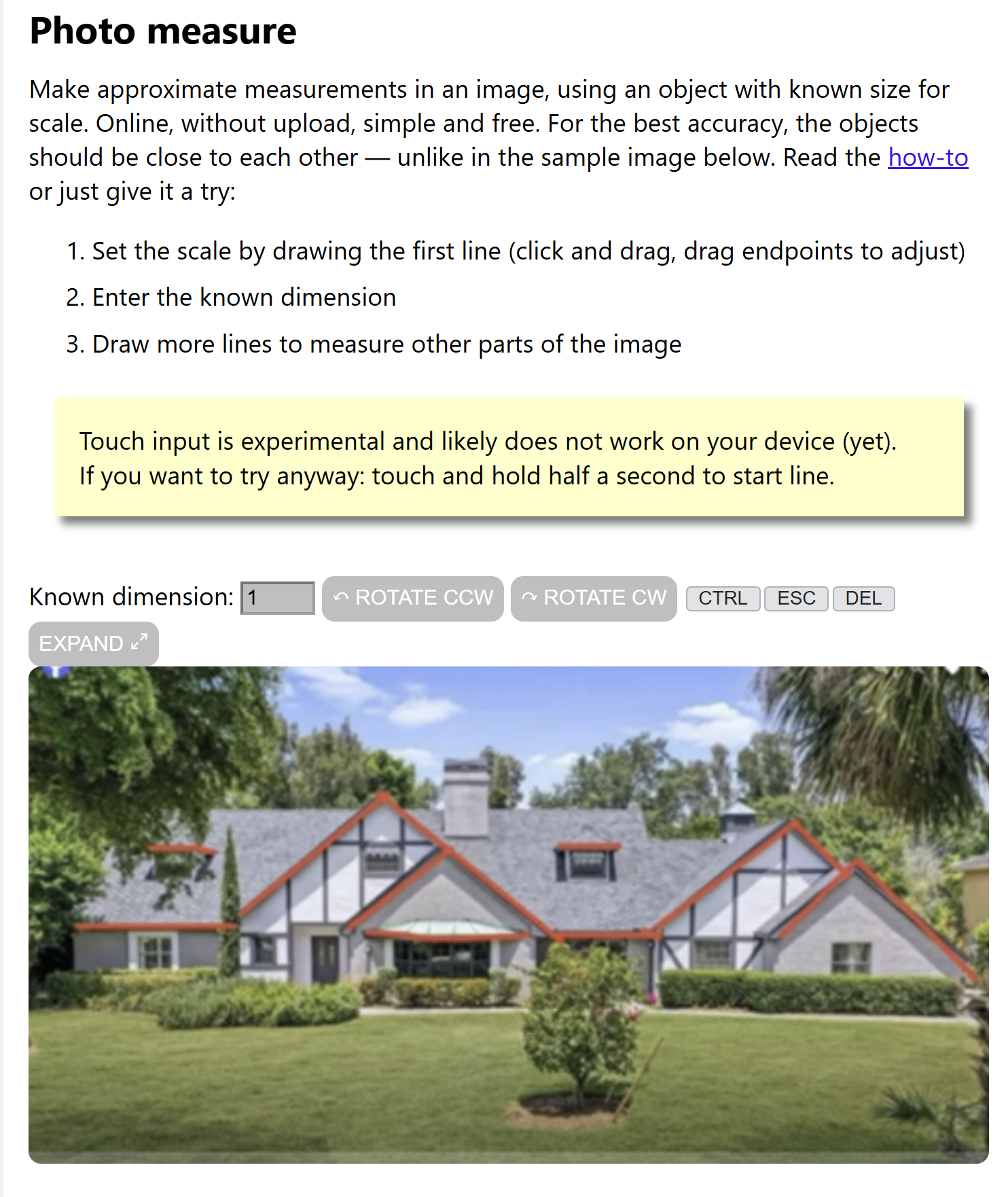
Pro Tip: When measuring complex structures, always account for architectural features that might not be immediately visible in the photo, such as door overhangs or roof extensions.
Tool #2: Image Measurement
This user-friendly tool offers enhanced zoom capabilities for more precise measurements:
1. Import your photo
2. Use the zoom function to get a clearer view
3. Set your reference point (again, using a door or known object)
4. Take measurements by clicking points along the structure
5. Calculate total measurements
6. Compare results with other tools for accuracy
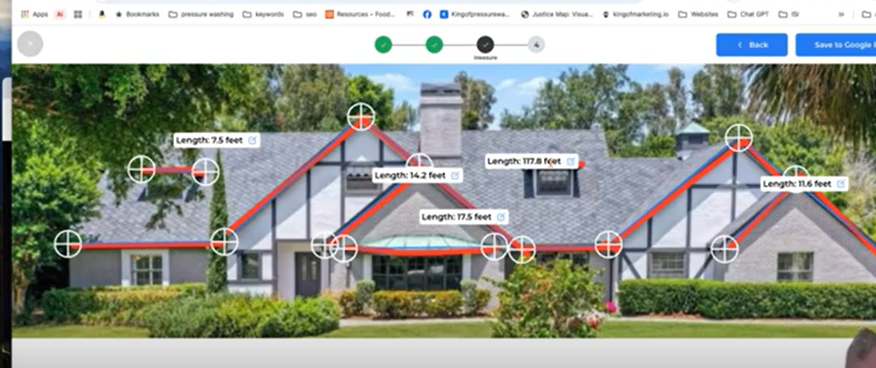
Tool #3: Canva - The Creative Solution
While primarily known for design work, Canva offers a surprisingly effective measurement solution:
1. Upload your photo to a YouTube thumbnail template
2. Use the ruler element tool
3. Set your reference measurement (3 feet for a standard door)
4. Duplicate and rotate the ruler to measure different sections
5. Track your measurements in increments (10 feet, 20 feet, etc.)
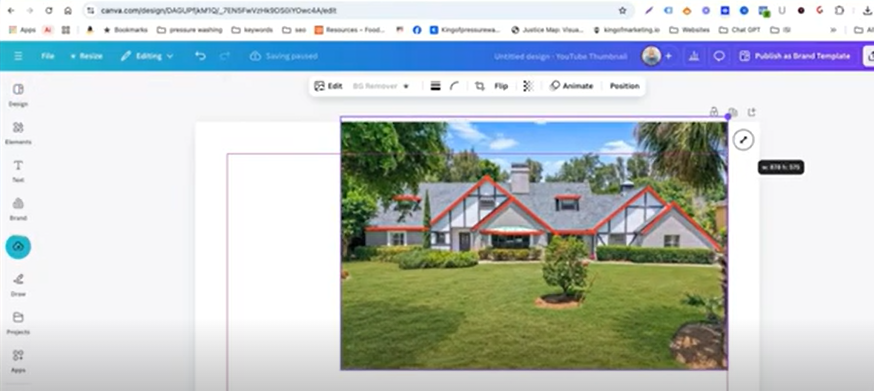
Best Practices for Digital Measuring
1. Use Known Reference Points
- Standard door width (3 feet)
- Garage doors (8 feet for single, 16 feet for double)
- Windows or other standard architectural features
2. Always Add a Buffer
- Include a 10% margin for error
- Account for hidden features not visible in photos
- Better to overestimate slightly than underestimate
3. Cross-Reference Your Results
- Use multiple tools to verify measurements
- Compare results between different methods
- Look for consistency in measurements
Common Pitfalls to Avoid
- Don't forget to account for:
- Door overhangs
- Architectural protrusions
- Roof extensions
- Corner details
- Changes in elevation
When to Use Which Tool
- ELEIF: Best for straight-line measurements and simple structures
- Image Measurement: Ideal for detailed work requiring zoom capability
- Canva: Perfect for quick estimates and visual reference points
Final Tips
1. Always verify your reference measurements
2. Take multiple measurements when possible
3. Document your process for consistency
4. Consider seasonal changes or structural variations
5. Keep records of your measurements for future reference
Remember, the goal isn't just to get a number – it's to get an accurate measurement that you can confidently use for project planning and execution. Whether you're a professional contractor or a DIY enthusiast, these tools can help you achieve precise measurements without stepping foot on the property.
Want to learn more about construction measurements and professional techniques? Visit ChristmasLights.io for additional resources and tips from industry experts.
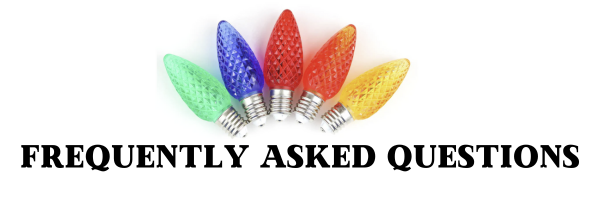
Q: Why should I use multiple apps to measure the same building?
A: Using multiple measurement tools helps verify your calculations and ensures accuracy. Each tool has its own strengths - for example, Image Measurement offers better zoom capabilities, while Canva provides easy-to-duplicate measurement units. By cross-referencing results between different apps, you can catch potential errors and arrive at the most accurate measurement.
Q: What's the best reference point to use when measuring from a photo?
A: The most reliable reference points are standardized building features:
- A standard door (3 feet wide)
- A garage door (8 feet for single, 16 feet for double)
- Standard windows
Always try to use the garage door as your first choice since it provides a larger reference point, which can lead to more accurate measurements across the entire structure.
Q: Why should I add 10% to my measurements?
A: Adding 10% serves as a safety buffer for several reasons:
- Accounts for hidden architectural features not visible in photos
- Compensates for potential measurement errors
- Covers unexpected protrusions or overhangs
- Ensures you have enough materials for the project
It's better to slightly overestimate than to run short on materials or underquote a project.
Q: Can these tools replace physical measurements?
A: While these digital tools are extremely helpful for initial estimates and remote measurements, they work best as complementary tools to physical measurements. For final, detailed work, it's still recommended to take physical measurements when possible. However, these apps are excellent for:
- Initial project estimates
- Remote quotes
- Preliminary planning
- Situations where physical access isn't immediately possible
Q: What can cause inaccurate measurements when using these apps?
A: Several factors can affect measurement accuracy:
- Using an incorrect reference point size
- Not accounting for perspective in photos
- Overlooking architectural features like overhangs
- Poor photo quality or angle
- Not considering depth in protruding features
To minimize errors, always use clear photos taken straight-on, verify your reference measurements, and cross-check results between different tools.
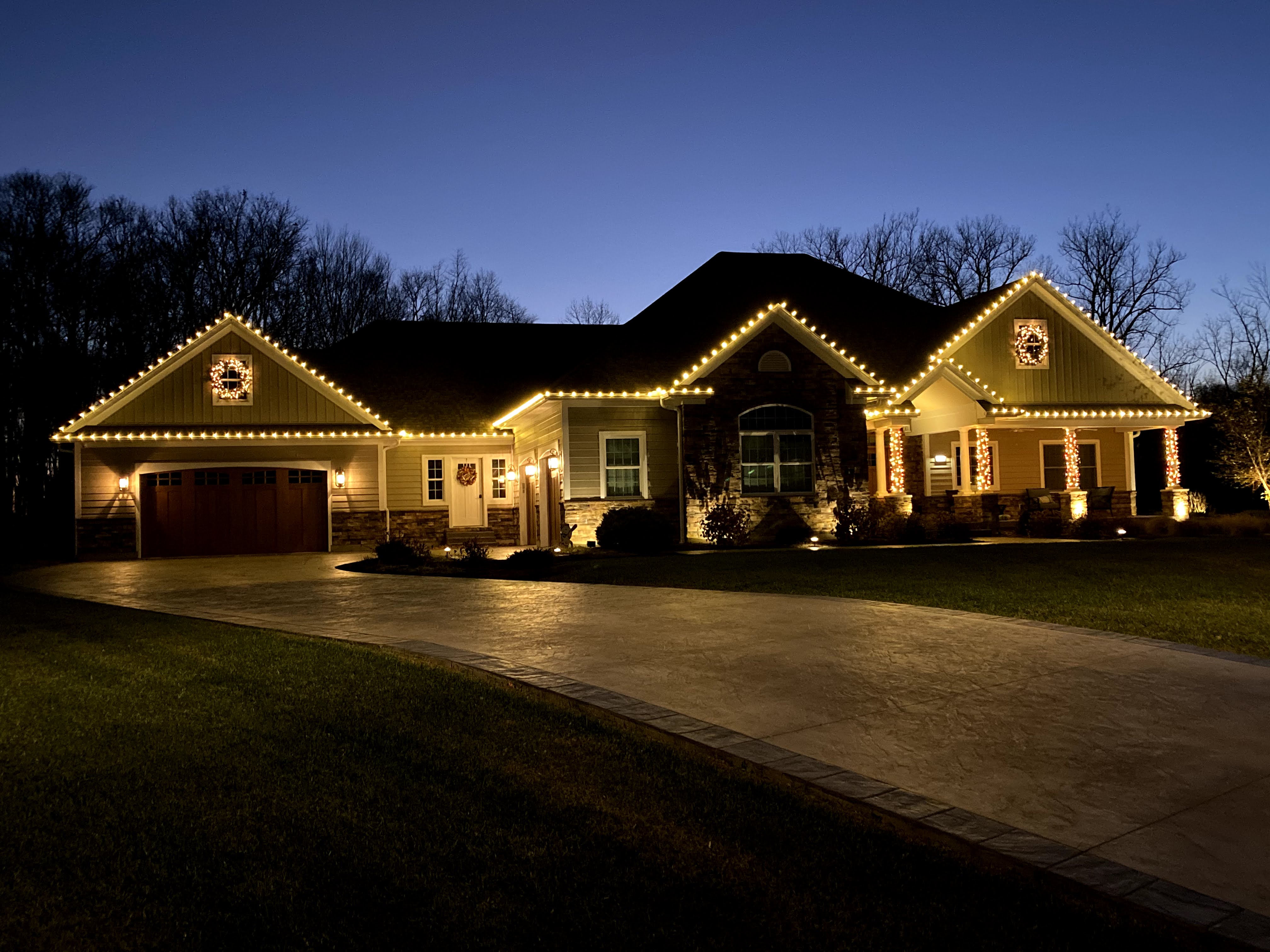
Q: Are these tools really free to use?
A: Yes, all three tools mentioned (ELEIF, Image Measurement, and Canva) offer free versions that include their measurement capabilities. While Canva does have a premium version, the measurement features discussed are available in the free version.
Q: How do I handle complex architectural features like bay windows or irregular shapes?
A: For complex features:
1. Break down the measurement into smaller, manageable sections
2. Measure each section individually
3. Account for depth and protrusions
4. Add extra buffer for irregular shapes
5. Consider taking multiple photos from different angles to better understand the structure
Q: What's the best way to document measurements for future reference?
A: Best practices for measurement documentation include:
- Take screenshots your measurements in each app
- Create a spreadsheet with all measurements and calculations
- Note which reference points were used
- Record the date and conditions of measurement
- Save the original photos used for measuring
- Document any assumptions or special considerations made
Q: How accurate are these digital measuring tools?
A: When used correctly with proper reference points and clear photos, these tools can be accurate within 5-10% of physical measurements. However, accuracy depends on:
- Quality and angle of the reference photo
- Accuracy of the reference point measurement
- Complexity of the structure
- User expertise in using the tools
This is why using multiple tools and adding a 10% buffer is recommended for professional estimates.
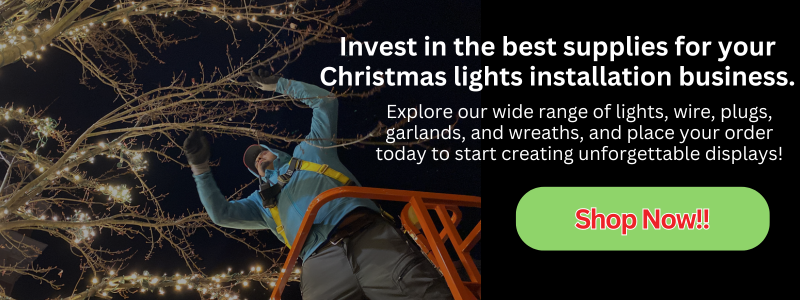
Have more questions about digital measuring techniques? Visit ChristmasLights.io for additional resources and expert guidance.
Copyright ©2024 All Right Reserved website designed by christmaslights.io
Terms of Service / Privacy Policy
Have questions or need assistance?
Contact us at (855)619-LITE


